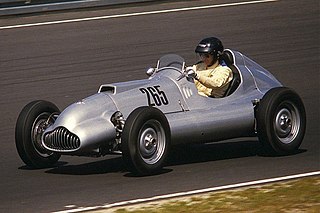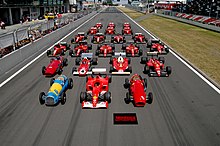
Juan Manuel Fangio, nicknamed El Chueco or El Maestro, was an Argentine racing car driver. He dominated the first decade of Formula One racing, winning the World Drivers' Championship five times.

Emilio Giuseppe Farina, also known as Giuseppe Antonio "Nino" Farina, was an Italian racing driver and the first official Formula One World Champion in 1950. He was the Italian Champion in 1937, 1938 and 1939.

The 1953 Belgian Grand Prix was a Formula Two race held on 21 June 1953 at Circuit de Spa-Francorchamps. It was race 4 of 9 in the 1953 World Championship of Drivers, which was run to Formula Two rules in 1952 and 1953, rather than the Formula One regulations normally used. The 36-lap race was won by Ferrari driver Alberto Ascari after he started from second position. His teammate Luigi Villoresi finished second and Maserati driver Onofre Marimón came in third.
The 1951 Formula One season was the fifth season of FIA Formula One motor racing. It featured the 1951 World Championship of Drivers, which commenced on 27 May 1951 and ended on 28 October after eight races. The season also included 14 races open to Formula One cars but did not count towards the championship standings.

The Argentine Grand Prix was a round of the Formula One championship, held intermittently from 1953 to 1998, all at the same autodrome in the Argentine national capital of Buenos Aires.

Aurelio Lampredi was an Italian automobile and aircraft engine designer.

Gioacchino Colombo was an Italian automobile engine designer.

Felice Bonetto was a courageous racing driver who earned the nickname Il Pirata.
The British Racing Motors V16 was a supercharged 1.5-litre V-16 cylinder racing engine built by British Racing Motors (BRM) for competing in Formula One motor racing in the immediate aftermath of World War II. Designed in 1947 and raced until 1954–55, it produced 600 bhp (450 kW) at 12,000 rpm, although test figures from Rolls-Royce suggested that the engine would be able to be run at up to 14,000rpm.

The Mercedes-Benz W196 was a Formula One racing car produced by Mercedes-Benz for the 1954 and 1955 F1 seasons. Successor to the W194, in the hands of Juan Manuel Fangio and Stirling Moss it won 9 of 12 races entered and captured the only two world championships in which it competed.

The Alfa Romeo 158/159, also known as the Alfetta, is a Grand Prix racing car produced by Italian manufacturer Alfa Romeo. It is one of the most successful racing cars ever; the 158 and its derivative, the 159, took 47 wins from 54 Grands Prix entered. It was originally developed for the pre-World War II voiturette formula (1937) and has a 1.5-litre straight-8 supercharged engine. Following World War II, the car was eligible for the new Formula One introduced in 1947. In the hands of drivers such as Nino Farina, Juan Manuel Fangio and Luigi Fagioli, it dominated the first two seasons of the World Championship of Drivers.

The Maserati 4CL and its derived sister model the Maserati 4CLT are single-seat open-wheel Grand Prix racing cars that were designed and built by Maserati. The 4CL was introduced at the beginning of the 1939 season, as a rival to the Alfa Romeo 158 and various ERA models in the voiturette class of international Grand Prix motor racing. Although racing ceased during World War II, the 4CL was one of the front running models at the resumption of racing in the late 1940s. Experiments with two-stage supercharging and tubular chassis construction eventually led to the introduction of the revised 4CLT model in 1948. The 4CLT was steadily upgraded and updated over the following two years, resulting in the ultimate 4CLT/50 model, introduced for the inaugural year of the Formula One World Championship in 1950. In the immediate post-war period, and the first two years of the Formula One category, the 4CLT was the car of choice for many privateer entrants, leading to numerous examples being involved in most races during this period.

The Alfa Romeo Tipo 308 or 8C-308 is a Grand Prix racing car made for the 3 litre class in 1938. Only four cars were produced, actually modified from Tipo C with the engine mounted lower into the chassis and a slimmer body. The chassis was derived from the Tipo C and the engine from the 8C 2900. The 308 was engineered by Gioacchino Colombo under the control of Enzo Ferrari who was then in charge of Alfa's racing team, Alfa Corse. The car debuted at the Pau Grand Prix in 1938, where two cars were entered to race, one for Tazio Nuvolari and the other for Luigi Villoresi. Both drivers had to withdraw from competition, however Nuvolari had by then set a lap record. The next race was the Tripoli Grand Prix. The new 312 and 316 were entered, but they had engine trouble during practice and Clemente Biondetti took the start at the wheel of the 308 held in reserve. He failed to finish, while Hermann Lang, driving a Mercedes-Benz W154, was the winner. In this race, Eugenio Siena, driving a 312, was killed after hitting a wall.

The BRM Type 15 was a Formula One racing car of the early 1950s, and the first car produced by British Racing Motors. The car was fitted with a revolutionary and highly complex supercharged 1.5-litre British Racing Motors V16 which produced considerably more power than any of its contemporaries.

The Buenos Aires Grand Prix is a motor race held in Buenos Aires, Argentina.

There have been 25 Formula One drivers from Argentina including one World Drivers' Champion. Juan Manuel Fangio, who is regarded as one of the greatest drivers of all time, won the title five times in the first eight seasons of the championship and was twice a runner-up.
Maserati made four naturally-aspirated, V12 racing engines, designed for Formula One; between 1951 and 1969. The first was an experimental O.S.C.A. engine; in accordance with the 4.5 L engine regulations imposed by the FIA for 1951. Their second engine was 250 F1 V12; in accordance with the 2.5 L engine regulations set by the FIA. Their last two V12 engines were customer engines supplied to Cooper; between 1966 and 1969. The Tipo 9 / F1 and Tipo 10 /F1, which were both manufactured to the FIA's 3.0 L engine regulations for 1966. One sports car, a modified version of the Maserati 350S, also used V12 engine, with a 3.5 L (210 cu in) displacement, and produced 335 hp (250 kW).

The Veritas Meteor was a Formula One and Formula 2 race car that raced for Veritas and private stables from 1951 until 1954.

The Ferrari 125 C is an open-wheel single-seater racing car, designed, developed, and produced by Ferrari in 1947 as a single example. It competed primarily in Formula Libre contests and events.

The Ferrari 166 F2 is an open-wheel formula racing single-seater car, designed, developed and built by Italian manufacturer and team Scuderia Ferrari, for Formula 2 racing, in 1948. This is the car in which Argentinian driver, and eventual five-time Formula One world champion, Juan Manuel Fangio, became known in Europe.



















